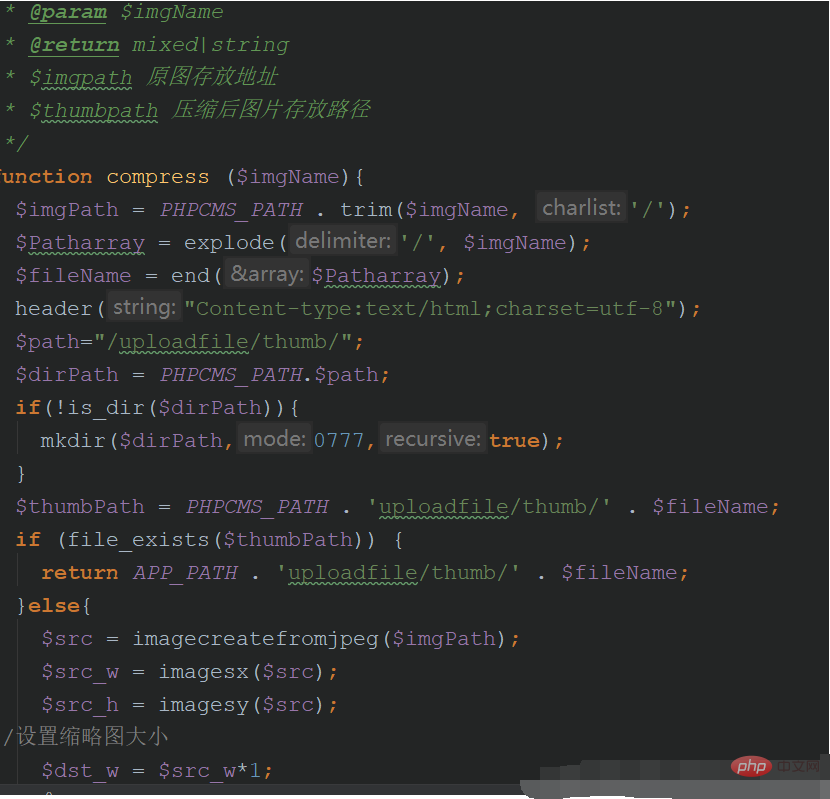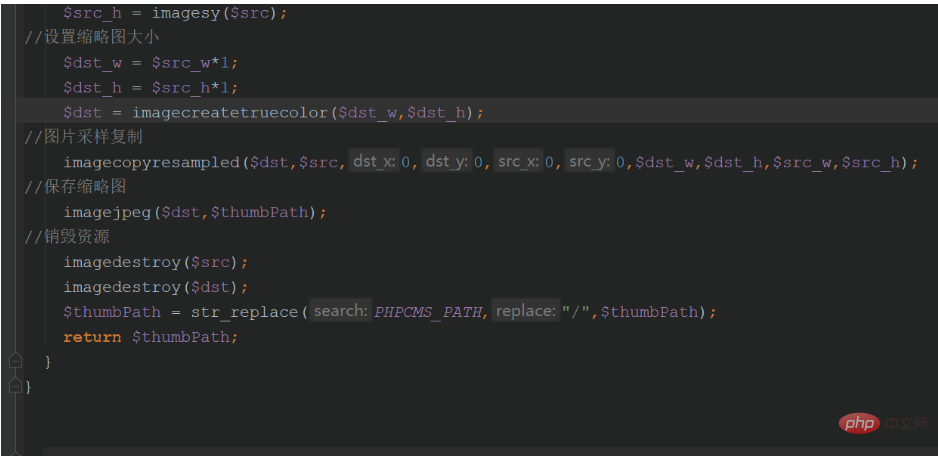Maison >Tutoriel CMS >PHPCMS >Comment compresser des images avec phpcms
Comment compresser des images avec phpcms
- 藏色散人original
- 2020-07-21 09:46:142573parcourir
Comment compresser des images avec phpcms : recherchez et ouvrez d'abord le fichier "extention.func.php" ; puis écrivez une méthode de compression automatique dans la classe publique et enfin passez l'instruction "{compress ($rs[' thumb' ])}" peut être appelé directement dans la page html.

Fonction de compression automatique d'image phpcms
Écrivez une méthode de compression automatique dans la classe publique :
phpcms\libs\functions\extention.func.php
**
@param $imgName
@return mixed|string
$imgpath 原图存放地址
$thumbpath 压缩后图片存放路径
*/
function compress ($imgName){
imgPath=PHPCMSPATH.trim(imgPath = PHPCMS_PATH . trim(imgPath=PHPCMS
P
ATH.trim(imgName, ‘/’);
$Patharray = explode(’/’, $imgName);
fileName=end(fileName = end(fileName=end(Patharray);
//创建thumb文件夹,保存压缩后的图片
header(“Content-type:text/html;charset=utf-8”);
$path="/uploadfile/thumb/";
dirPath=PHPCMSPATH.dirPath = PHPCMS_PATH.dirPath=PHPCMS
P
ATH.path;
if(!is_dir(KaTeX parse error: Expected '}', got 'EOF' at end of input: …h)){ mkdir(dirPath,0777,true);
}
$thumbPath = PHPCMS_PATH . ‘uploadfile/thumb/’ . fileName;if(fileexists(fileName;if (file_exists(fileName;if(file
e
xists(thumbPath)) {
return APP_PATH . ‘uploadfile/thumb/’ . $fileName;
}else{
src=imagecreatefromjpeg(src = imagecreatefromjpeg(src=imagecreatefromjpeg(imgPath);
srcw=imagesx(src_w = imagesx(src
w
=imagesx(src);
srch=imagesy(src_h = imagesy(src
h
=imagesy(src);
//设置缩略图大小
$dst_w = $src_w1;
$dst_h = $src_h1;
dst=imagecreatetruecolor(dst = imagecreatetruecolor(dst=imagecreatetruecolor(dst_w,dsth);//图片采样复制imagecopyresampled(dst_h);//图片采样复制imagecopyresampled(dst
h
);//图片采样复制imagecopyresampled(dst,src,0,0,0,0,src,0,0,0,0,src,0,0,0,0,dst_w,dsth,dst_h,dst
h
,src_w,srch);//保存缩略图imagejpeg(src_h);//保存缩略图imagejpeg(src
h
);//保存缩略图imagejpeg(dst,thumbPath);//销毁资源imagedestroy(thumbPath);//销毁资源imagedestroy(thumbPath);//销毁资源imagedestroy(src);
imagedestroy($dst);
thumbPath=strreplace(PHPCMSPATH,"/",thumbPath = str_replace(PHPCMS_PATH,"/",thumbPath=str
r
eplace(PHPCMS
P
ATH,"/",thumbPath);
return $thumbPath;
}
} 

Recommandé : "tutoriel phpcms"
Appelez
{compress ($rs[‘thumb’])} directement dans la page htmlCe qui précède est le contenu détaillé de. pour plus d'informations, suivez d'autres articles connexes sur le site Web de PHP en chinois!
Déclaration:
Le contenu de cet article est volontairement contribué par les internautes et les droits d'auteur appartiennent à l'auteur original. Ce site n'assume aucune responsabilité légale correspondante. Si vous trouvez un contenu suspecté de plagiat ou de contrefaçon, veuillez contacter admin@php.cn
Article précédent:Comment utiliser la fonction commentaire de phpcmsArticle suivant:Comment utiliser la fonction commentaire de phpcms

